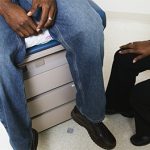But those treated with the imaging approach were treated with three times the amount of biologics than the other group.
“There is no clinical, functional or structural advantage of targeting imaging remission compared with clinical remission—or even low disease activity,” Dr. Smolen said, “but it results in overtreatment.”
DECT & Ultrasound in Gout
Alexander So, MD, head of rheumatology at the University of Lausanne in Switzerland, in a review of recent gout literature, said recent findings have offered new insights into diagnosis, illustrated the need for greater patient education, and underscored the continued value of traditional treatments.
Scoring systems have been developed for diagnosing gout using dual-energy CT (DECT).4 And DECT has been shown to be able to detect asymptomatic deposits in patients who have hyperuricemia in the setting of chronic renal disease.
“I think this is going to be an emerging technique [that] is going to be used more and more,” Dr. So said. The drawback is that this is very “machine dependent,” so the assessments are reliant on a single machine’s data, and it is still costly and not widely available.
Ultrasound has proved highly specific for a gout diagnosis, but only moderately sensitive, according to recent studies.5
A study from earlier this year found that the optimal dose of allopurinol is determined by body weight & the use of diuretics, which runs contrary to current guidelines.
Patient Education
A recent study suggests that patient education is an ongoing reason why gout, a curable disease, goes uncured so often, Dr. So said.6
A study out of the United Kingdom found that adherence to prescribed treatment is poor, that the number of patients in that country who are receiving urate-lowering therapy (ULT) has not increased although the disease prevalence has increased and that targets are not being reached among those who are on ULT.7
Traditional treatment: Recent studies have suggested that optimal use of older treatments, such as allopurinol, is probably the best option for gout patients.
A study from earlier this year found that the optimal dose of allopurinol is determined by body weight and the use of diuretics, which runs contrary to current guidelines.8
“If you are taking diuretics and you have poor renal function, you are likely to need very high doses of allopurinol,” Dr. So said. The study conveys “how important adjusting the dose is in the individual patient.”
A recent six-month study of allopurinol safety outcomes—the LASSO study—found the drug was well tolerated, with rash in just 1.5% of patients. With the HLA-B*58:01 gene associated with allopurinol hypersensitivity syndrome, researchers are now studying cost-effectiveness of genotyping for this gene.9


